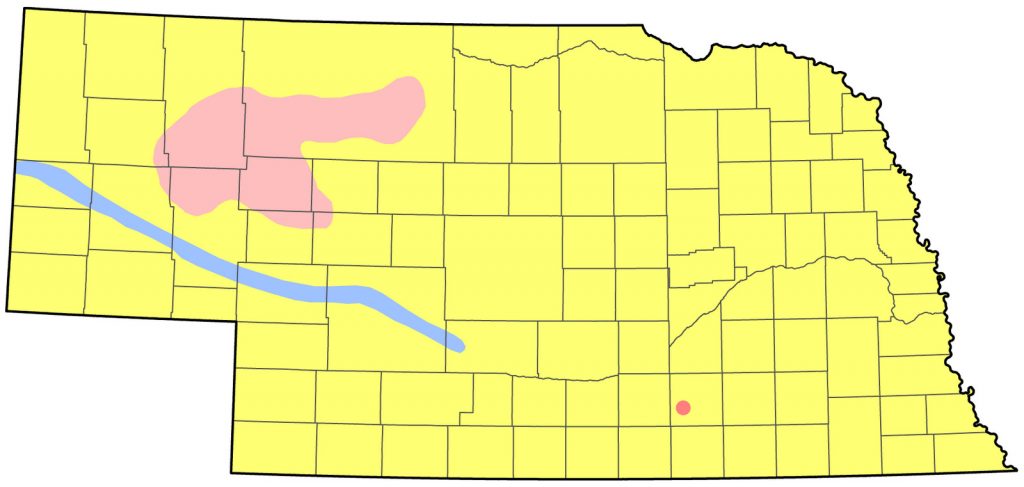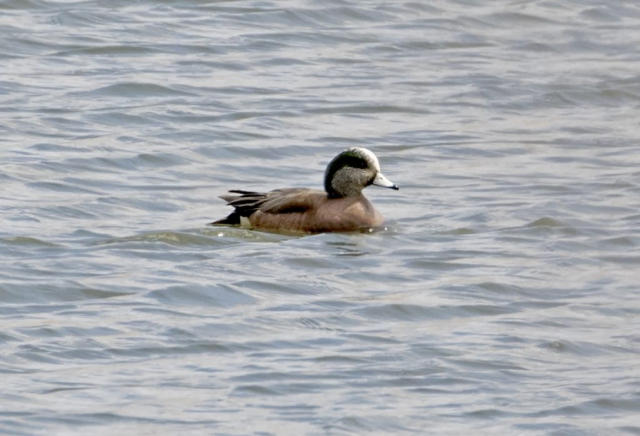Mareca americana
Status: Common, locally abundant, regular spring and fall migrant statewide. Rare regular breeder northcentral and northwest, rare casual elsewhere. Uncommon regular summer visitor northcentral and northwest, rare casual elsewhere. Rare, locally uncommon, regular winter visitor Platte and North Platte River Valley counties southward and Missouri River Valley north to Knox Co, rare casual elsewhere.

Documentation: Specimen: UNSM ZM7676, 12 Apr 1913 Lancaster Co.
Taxonomy: This species was recently moved from genus Anas to genus Mareca, based on genetic studies (Chesser et al 2017).
No subspecies are recognized (AviList 2025).
There are Nebraska records of American Wigeon hybrids with Eurasian Wigeon and Mallard; see Eurasian Wigeon x American Wigeon (hybrid), and American Wigeon x Mallard (hybrid).
A normal variant in male American Wigeons is the colloquially named “Storm Wigeon”, or “White-cheeked Wigeon”, prized by hunters, that has white cheeks instead of the usual gray (Mini et al 2020). One was in Antelope Co 8 Apr 2018 and possibly the same bird was there 31 Mar 2020, and another was in Dixon Co 18 Mar 2024.
Spring: Feb 10, 11, 12 <<<>>> Jul 3, 3, 3
Early dates above are north of the winter range. The initiation of migration is coincident with the thaw of frozen rivers, lakes and ponds, typically in late Feb. Numbers peak in mid-Apr, with a few stragglers into early May and even into June. It is difficult to determine the end of spring migration as lingering at wetlands statewide into early Jul occurs often. Late dates above are away from the potential breeding range; there is a later date 6 Jul 1988 Stanton Co.
- High counts: 2581 at North Platte NWR, Scotts Bluff Co 14 Apr 1995, 2200 at Harvard WPA, Clay Co 9 Apr 2000, 2000 at Cedar Vue, Lake McConaughy 28 Mar 2024, and 1350 at Swanson Reservoir, Hitchcock Co 17 Apr 2002.
Summer: Currently, American Wigeon is a rare breeder in the state; Mollhoff (2022) noted seven documented nesting records. Five of the seven records were at Valentine NWR in 1993 (two) and 1998 (five) (McDaniel; Mollhoff 2022). The other two records were of a nest at Valentine NWR in 1938 (Sharp 1939) and a hen with a brood of 10 on 30 Jun 2001 in the Rainwater Basin (Jorgensen 2012). Confirmed BBA breeding was reported by Mollhoff (2001) at Valentine NWR, Cherry Co and by Mollhoff (2016) in southeast Garden Co.
Although there are few documented records of breeding, there are numerous summer sightings in areas where breeding might occur. Most of these are in the western Sandhills in southern Sheridan, northern Garden, and Grant Cos, extending northeastward to Valentine NWR in Cherry Co. Reports of presumed non-breeders in summer generally involve low numbers, but 1000 were estimated in the Maverick Lake area of Crescent Lake NWR, Garden Co 5 Aug 2021.
Reports from counties adjacent to the breeding range shown in the above map that might indicate local nesting are from Scotts Bluff, Sioux, Dawes, McPherson, and Thomas Cos. There were several reports at Funk WPA, Phelps Co 1997-2001 suggestive of local nesting there, and one was there 30 Jul 2023.
Elsewhere, summer reports (7 Jul-24 Aug) are few: 8 Aug 2020 eight in Hall Co, 9 Aug 2017 Scotts Bluff Co, and 12 Aug 2009 Dawson Co.
- Breeding Phenology:
Eggs: 25 May- 22 Jun (Mollhoff 2022).
Fall: Aug 24, 25, 25 <<<>>> Jan 2, 2, 2
Late dates above are away from the winter range. See Winter for later dates.
The beginning of true fall migration is evident in early Sep although failed breeders and males begin to move and to assemble in Jun-Jul to molt (Baldassarre 2014). Examples of likely molt migrants are 50 on 1 Aug 2024 at Crescent Lake NWR, Garden Co, 20 on 18 Aug 2020 at Crescent Lake NWR, and 24 on 25 Aug 2006 in Keith Co. Five reports from Lake Ogallala, Keith Co 15 Jun-27 Jul suggest this is a molt location, as it is for Common Merganser (see that species). The Rainwater Basin may also be such a site; there are 13 reports 16 Jun-22 Jul. Probable molt migrants were 10 in Harlan Co 27 Jul 2000, four in Keith Co 7 Aug 2020, and eight in Hall Co 8 Aug 2020.
Peak migration occurs Oct-early Nov, but significant numbers may persist into mid-Nov and early Dec.
- High counts: 1670 at Lake McConaughy 15 Oct 2000, 1600 at Lake Ogallala, Keith Co 28 Oct 2024, 1500 at Palmer Lake, southwest Sheridan Co 11 Nov 1994, and 1500 at Lake Ogallala 17 Oct 2015. “Thousands” were at Winters Creek Lake, Scotts Bluff Co 7 Nov 2004.
Winter: Small numbers may remain well into Dec and even Jan given open water, although wintering is regular only along the North Platte River Valley and is rare east of Dawson Co and elsewhere in the state. Late high counts were 1100 at Lake Ogallala, Keith Co 23 Dec 2024, and 624 at Lake McConaughy, Keith Co 30-31 Dec 2011. As many as 286 wintered on Lake Ogallala 1999-2000, and 100 wintered in Scotts Bluff Co 2002-2003 and 2003-2004. A Scottsbluff CBC high was the 684 there 18 Dec 2004.
There is a recent trend of wintering on or near the Missouri River, mostly in the Gavin’s Point Dam area, but beginning with 1-8 wintering at Carter Lake, Douglas Co in four of the years 2011-2012 through 2016-2017. Notable was one that wintered at Ta-Ha-Zouka Park, Madison Co 11 Jan-13 Feb 2021. In years since, there have been multiple reports of wintering in or near the Missouri River; best counts were up to eight at Kramper Lake, Dakota Co 9 Dec 2021-28 Feb 2022, up to seven at Gavin’s Point Dam area, Cedar Co Jan 2018, and up to four in the Gavin’s Point Dam area 19 Dec 2021- 5 Feb 2022.
There are few mid-winter (3 Jan-9 Feb) records away from the winter range: 4 Jan 2021 Madison Co, 14 Jan 2019 Cherry Co, 22-24 Jan 2019 Madison Co, and 5 Feb 1995 Seward Co.
Images
Abbreviations
BBA: Breeding Bird Atlas
CBC: Christmas Bird Count
NWR: National Wildlife Refuge
UNSM: University of Nebraska State Museum
WPA: Waterfowl Production Area (Federal)
WTP: Water Treatment Plant
Literature Cited
AviList Core Team, 2025. AviList: The Global Avian Checklist, v2025. https://doi.org/10.2173/avilist.v2025.
Baldassarre, G. 2014. Ducks, geese, and swans of North America. Johns Hopkins University Press, Baltimore, Maryland, USA.
Chesser, R.T., K.J. Burns, C. Cicero, J.L. Dunn, A.W. Kratter, I.J. Lovette, P.C. Rasmussen, J. V. Remsen, Jr., J.D. Rising, D.F. Stotz, and K. Winker. 2017. Fifty-eighth supplement to the American Ornithological Society’s Check-list of North American Birds. Auk 134: 751-773.
Jorgensen, J.G. 2012. Birds of the Rainwater Basin, Nebraska. Nebraska Game and Parks Commission, Lincoln, Nebraska, USA.
Mini, A.E., E.R. Harrington, E. Rucker, B.D. Dugger, and T.B. Mowbray. 2020. American Wigeon (Mareca americana), version 1.0. In Birds of the World (A. F. Poole, Editor). Cornell Lab of Ornithology, Ithaca, NY, USA. https://doi.org/10.2173/bow.amewig.01.
Mollhoff, W.J. 2001. The Nebraska Breeding Bird Atlas 1984-1989. Nebraska Ornithologists’ Union Occasional Papers No. 7. Nebraska Game and Parks Commission, Lincoln, Nebraska, USA.
Mollhoff, W.J. 2016. The Second Nebraska Breeding Bird Atlas. Bull. Univ. Nebraska State Museum Vol 29. University of Nebraska State Museum, Lincoln, Nebraska, USA.
Mollhoff, W.J. 2022. Nest records of Nebraska birds. Nebraska Ornithologists’ Union Occasional Paper Number 9.
Sharp, W.M. 1939. Notes on certain ducks nesting in Nebraska. NBR 7: 1-4.
Recommended Citation
Silcock, W.R., and J.G. Jorgensen. 2025. American Wigeon (Mareca americana). In Birds of Nebraska — Online. www.BirdsofNebraska.org
Birds of Nebraska – Online
Updated 5 Jul 2025

